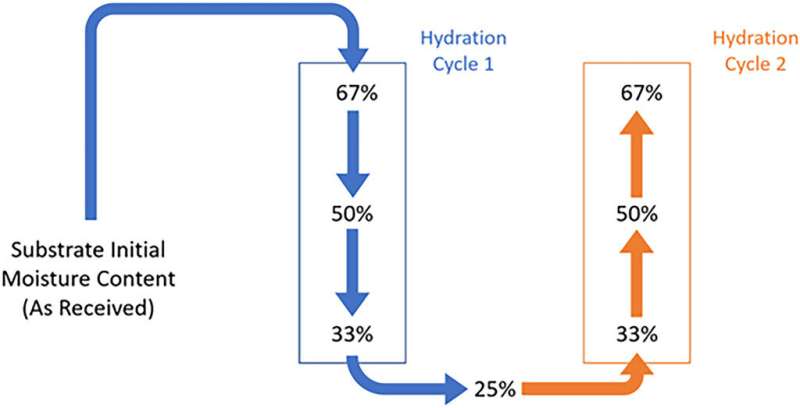This article has been reviewed according to Science X's editorial process and policies. Editors have highlighted the following attributes while ensuring the content's credibility:
fact-checked
peer-reviewed publication
trusted source
proofread
Traditional horticultural substrate's sorptive behavior quantified

The objective of a recent study published in HortScience was to quantify the sorptive effects on substrate wettability and water-holding capacity. Inferences into the effectiveness of the substrate to capture water have been difficult to demonstrate statistically. To assist in this, researchers used a monomolecular exponential model to quantify water holding capacity and the irrigation volume required to reach that capacity. Because the wetting behavior of peat can be greatly affected by hydrophobicity, a second objective was to determine the effectiveness of hydrophilic coconut coir in mitigating the initial hydrophobicity of a peat substrate.
The substrate materials tested were a 6-month aged loblolly pine bark, sphagnum peat moss, and coconut coir.
Blending coir with peat improved substrate wettability substantially. Adding just 15% coir by volume allowed peat to maintain a VWC of ∼55% through a wetting and drying cycle. With blends of 30% and 45% coir, it was difficult to determine whether the effects were a result of the hydrophilic nature or smaller particle size of the coir. Smaller volumes of coir blended with peat should be evaluated to determine the threshold of coir to improve wettability.
The statistical approach used to quantify substrate wettability was helpful in identifying objectively the intercept at which a substrate approached its maximum volumetric water content (VWC) from overhead irrigation. Although the intercept at 99% of the maximum VWC was used for this study, the derivative of the monomolecular exponential model can be adjusted easily should the user determine a different threshold more valuable. Analyzing the data in this manner also draws attention to the variability demonstrated in this wettability procedure. Schulker et al. (2020) also recorded greater variability from surface irrigation than subirrigation when evaluating substrate hydration efficiency.
Data from these experiments provide evidence that the moisture content and preconditioning of a substrate can lead to differences in initial water capture efficiency. This information can be critical to growers, growing media manufacturers, and researchers alike. The wettability of peat was most affected by MC and the initial wetting and drying cycles. Hydration efficiency was improved in peat by blending in as little as 15% coir by volume. Future investigations should target the changes in sorptive behavior through multiple wetting and drying cycles, such as those experienced during plant production, and pragmatic solutions to improve substrate water use efficiency, such as improving the physical properties of pine bark and blended substrates.
More information: Paul C. Bartley et al, Quantifying the Sorptive Behavior of Traditional Horticultural Substrate Components Based on Initial Hydraulic Conditioning, HortScience (2022). DOI: 10.21273/HORTSCI16698-22
Journal information: HortScience
Provided by American Society for Horticultural Science





















